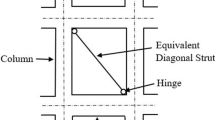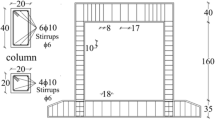Abstract
Purpose
This study investigates the seismic performance of vertical irregular steel moment-resisting frames subjected to mainshock–aftershock (MS–AS) seismic sequence. The building structures situated in a seismically active region experience sequence of earthquakes during their lifetime. These seismic sequences have the potential to increase the damage state of the structures. The irregular building structures are present due to availability of space, functional and architectural requirements etc. behave differently as compared to the regular buildings during earthquakes.
Methods
In this paper, three steel-moment resisting frames having different configuration i.e. 3, 6, and 9-storey were considered as a reference regular frame. Three vertical irregularities-stiffness, strength and combined stiffness and strength are introduced in three different locations (bottom, mid-height, and topmost storey) along the height of each building frames. These regular and vertically irregular frames are subjected to mainshocks alone and artificial MS–AS seismic sequences that are generated by using the repeated and randomized approach. The nonlinear time-history analysis is performed using computer software SAP 2000 on regular and irregular building frames subjected to mainshocks and MS–AS seismic sequence.
Results
The comparison between the seismic performance of vertically irregular and regular frames subjected to mainshocks alone and MS–AS seismic sequences shows that the vertical irregular frames have a significant effect on the distribution of mean interstorey drift demands along the height of building frames.
Conclusion
The effect of MS–AS seismic sequence on seismic demands of vertical irregular and regular frames have been increased compared to mainshocks. However, the repeated seismic sequences show smaller structural responses relative to the randomized seismic sequences.















Similar content being viewed by others
References
Abdollahzadeh G, Mohammadgholipour A, Omranian E (2017) Seismic evaluation of steel moment frames under Mainshock–aftershock sequence designed by elastic design and PBPD methods. J EarthqEng 23(10):1605–1628
Al-Ali AAK, Krawinkler H (1998) Effects of vertical irregularities on seismic behavior of building structures. Report No. 130, John A. Blume Earthquake Engineering Center, Stanford University, Stanford, CA
Amadio C, Fragiacomo M, Rajgelj S (2003) The effects of repeated earthquake ground motions on the non-linear response of SDOF systems. EarthqEng and StructDyn 32(2):291–308
ASCE/SEI 7-16 (2017) Minimum design loads for buildings and other structures. SEI, Reston, Virginia
Aschheim M, Black E (1999) Effects of prior earthquake damage on response of simple stiffness-degrading structures. EarthqSpect 15(1):1–24
Azghandi RR, Shakib H, Zakersalehi M (2020) Numerical simulation of seismic collapse mechanisms of vertically irregular steel high-rise buildings. J Constr Steel Res 166:105914
BIS. IS 1893 (Part 1)-2016 (2016) Indian standard criteria for earthquake resistant design of structures, part 1—general provisions and buildings (Sixth Revision). Bureau of Indian Standards: New Delhi, India
Chintanapakdee C, Chopra AK (2004) Seismic response of vertically irregular frames: response history and modal pushover analyses. J StructEng 130(8):1177–1185
EC 8 (2004) Design of structures for earthquake resistance. General rules seismic actions and rules for buildings. EN 1998–1:2004, European committee for standardization, Brussels
Fragiacomo M, Amadio C, Macorini L (2004) Seismic response of steel frames under repeated earthquake ground motions. Engstruct 26(13):2021–2035
Gupta A, Krawinkler H (1998) Seismic demands for performance evaluation of steel moment-resisting frame structures. Report No. 132; John A Blume Earthquake Engineering Center, Department of Civil and Environmental Engineering, Stanford University, Stanford, CA
Hatzigeorgiou GD, Liolios AA (2010) Nonlinear behavior of RC frames under repeated strong ground motions. Soil DynEarthqEng 30(10):1010–1025
Homaei F, Shakib H, Soltani M (2017) Probabilistic seismic performance evaluation of vertically irregular steel building considering soil–structure interaction. Int J Civil Eng 15(4):611–625
IBC (2003) International building code 2003. Illinois International Code Council (ICC), 2002 Inc
Kunnath SK, Nghiem Q, El-Tawil S (2004) Modeling and response prediction in performance-based seismic evaluation: case studies of instrumented steel moment-frame buildings. EarthqSpect 20(3):883–915
Lee K, Foutch DA (2004) Performance evaluation of damaged steel frame buildings subjected to seismic loads. J Struct Eng 130(4): 588–599
Le‐Trung K, Lee, K, Lee J, Lee DH (2012) Evaluation of seismic behaviour of steel special moment frame buildings with vertical irregularities. Struct D Tall Spec Bldg 21(3): 215–232
Li Q, Ellingwood BR (2007) Performance evaluation and damage assessment of steel frame buildings under main shock–aftershock earthquake sequences. EarthqEng and StructDyn 36(3):405–427
Lignos DG, Krawinkler H (2011) Deterioration modeling of steel components in support of collapse prediction of steel moment frames under earthquake loading. J StructEng 137(11):1291–1302
Mahin SA (1980) Effects of duration and aftershocks on inelastic design earthquakes. In: Proc., World Conf. on Earthquake Engineering, International Association for Earthquake Engineering (IAEE), Tokyo, Japan
Michalis F, Dimitrios V, Manolis P (2006) Evaluation of the influence of vertical irregularities on the seismic performance of a nine-storey steel frame. EarthqEngstructDyn 35(12):1489–1509
Nazri FM, Miari MA, Kassem MM, Tan CG, Farsangi EN (2019) Probabilistic evaluation of structural pounding between adjacent buildings subjected to repeated seismic excitations. Arab J SciEng 44(5):4931–4945
NBCC (2005) National building code of Canada 2005. National Research Council of Canada, Ottawa
Oyguc R, Toros C, Abdelnaby AE (2018) Seismic behavior of irregular reinforced-concrete structures under multiple earthquake excitations. Soil DynEarthqEng 104:15–32
Parekar SD, Datta D (2020) Seismic behaviour of stiffness irregular steel frames under mainshock–aftershock. Asian J Civil Eng 21:857–870
Pirizadeh M, Shakib H (2013) Probabilistic seismic performance evaluation of non-geometric vertically irregular steel buildings. J Const Steel Res 82:88–98
Raghunandan M, Liel AB, Luco N (2014) Aftershock collapse vulnerability assessment of reinforced concrete frame structures. EarthqEngStructDyn 44(3):419–439
Ruiz-García J, Aguilar JD (2017) Influence of modeling assumptions and aftershock hazard level in the seismic response of post-mainshock steel framed buildings. EngStruct 140:437–446
Ruiz-García J, Yaghmaei-Sabegh S, Bojórquez E (2018) Three-dimensional response of steel moment-resisting buildings under seismic sequences. EngStruct 175:399–414
SAP2000 (2012) Static and dynamic finite element analysis of structures. Version 14.2.4, Computers and Structures Inc., Berkeley
Somerville P, Smith N, Punyamurthula S, Sun J (1997) Development of ground motion time histories for phase II of the FEMA/SAC steel project. Report No. SAC/BD-97/04, SAC Background Document, Richmond, CA
Sunasaka Y, Kiremidjian AS (1993) A method for structural safety evaluation under mainshock-aftershock earthquake sequences. John A. Blume Earthquake Engineering Center
UBC (1997) Uniform Building Code. Volume 2. International Conference of Building Officials: Whittier, USA
USGS.: United States Geological Survey (2012). https://earthquake.usgs.gov/archive/product/poster/20110311/us/1552332847859/poster.pdf
Valmundsson EV, Nau JM (1997) Seismic response of building frames with vertical structural irregularities. J StructEng 123(1):30–41
Varadharajan S, Sehgal VK, Saini B (2012) Review of different structural irregularities in buildings. J of StructEng 39(5):393–418
Zhai CH, Wen WP, Chen Z, Li S, Xie LL (2013) Damage spectra for the mainshock–aftershock sequence-type ground motions. Soil DynEarthqEng 45:1–12
Zhang Y, Chen J, Sun C (2017) Damage-based strength reduction factor for nonlinear structures subjected to sequence-type ground motions. Soil DynEarthqEng 92:298–311
Author information
Authors and Affiliations
Corresponding author
Ethics declarations
Conflict of interest
On behalf of all authors, the corresponding author states that there is no conflict of interest.
Additional information
Publisher's Note
Springer Nature remains neutral with regard to jurisdictional claims in published maps and institutional affiliations.
Rights and permissions
About this article
Cite this article
Parekar, S.D., Datta, D. Seismic Evaluation of Vertically Irregular Steel Moment-Resisting Frames Under Mainshock–Aftershock Vibration. J. Vib. Eng. Technol. 9, 1413–1431 (2021). https://doi.org/10.1007/s42417-021-00305-x
Received:
Revised:
Accepted:
Published:
Issue Date:
DOI: https://doi.org/10.1007/s42417-021-00305-x




